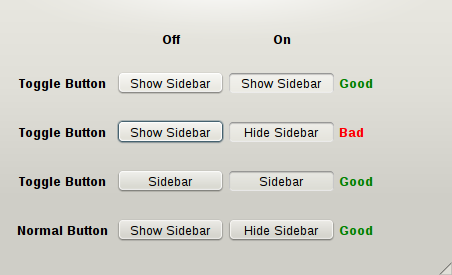Projects/Usability/HIG/Toggle Buttons
Definition
A toggle button is a button which stays down when clicked once and goes up when clicked a second time.
When to Use
Use a toggle button to indicate a state.
Example: A word processor should use toggle buttons to indicate the state of "Bold", "Italic" or "Underline" formatting.
![]() (Toggle buttons used in a rich text editor)
(Toggle buttons used in a rich text editor)
When not to Use
Do not use a toggle button to indicate an action.
Example: A music player should not use a toggle button to implement a combined Play/Pause button. It should use a normal button and adjust the icon and label to represent the action which would be performed when clicked.
Icon and Label
There are two ways to label a toggle button:
First possibility: Describe the state which is reached when the button is down
In this case the icon and label should not change when the button is down.
For example a button to toggle the visibility of a sidebar could say "Show Sidebar". It should still say "Show Sidebar" when the button is down: it should not be changed to "Hide Sidebar". Think of the button as a check box: when you click a check box you do not expect its label to change.
If you want to change the button text to "Hide Sidebar" when the sidebar is shown then you should use a normal button, not a toggle button.
It is worth noting the label of a toggle button does not need to contain a verb, as long as there is no ambiguity. In this example the label can be reduced to "Sidebar".
Second possibility: Describe the current state
In this case the label will often include a passive verb. For example a button to lock or unlock an element would say "Unlocked" when it is up and "Locked" when it is down. The icon should also change to match the label.



